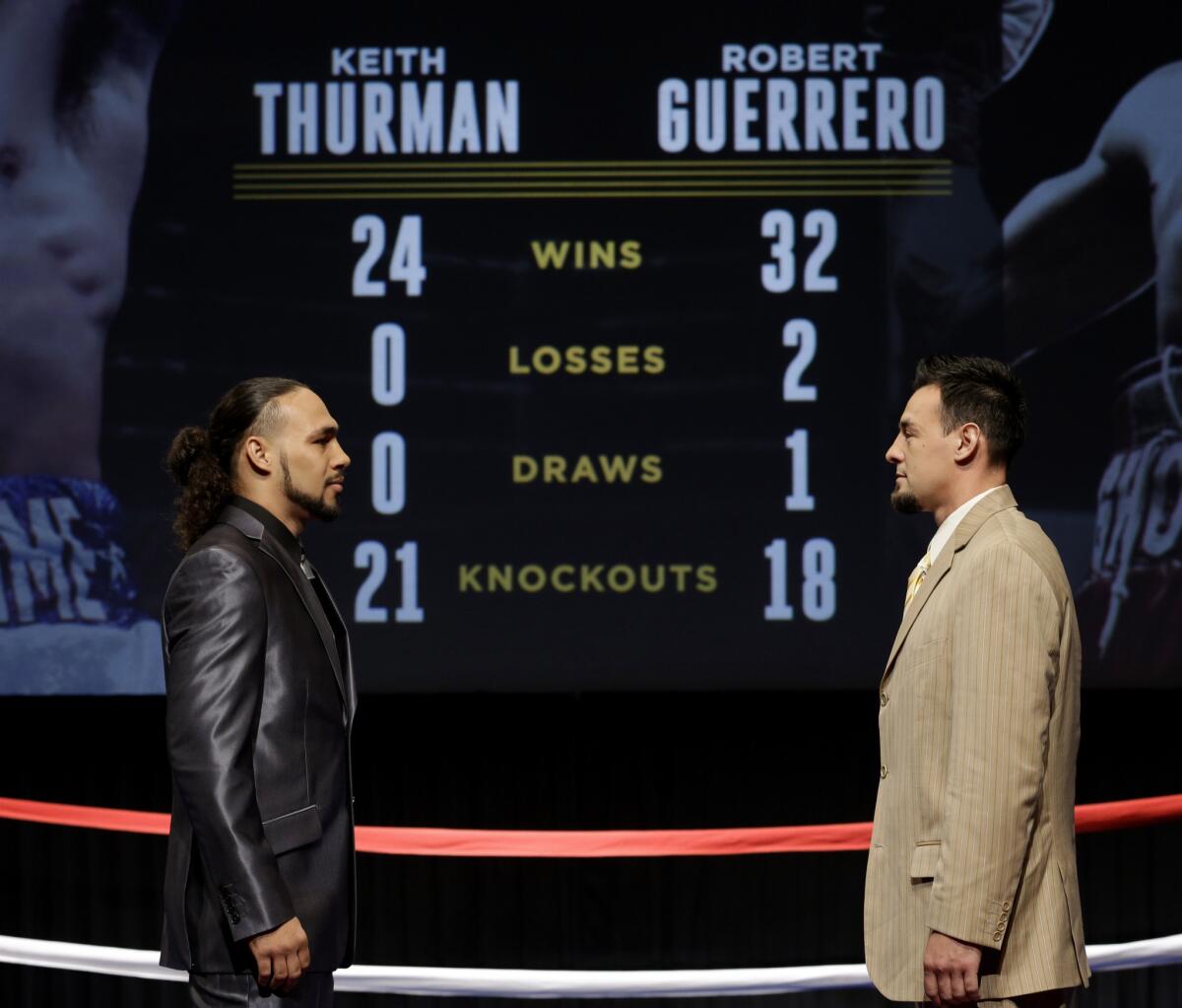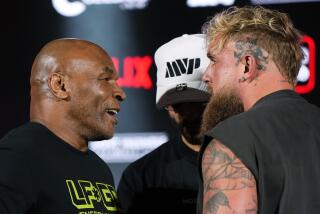Al Haymon is spending to put boxing on TV, but do the numbers add up?

A fight between Kieth Thurman and Robert Guerrero was the headline of of the Premiere Boxing Champions debut on NBC in March of 2015.
- Share via
Al Haymon, the reclusive manager of boxer Floyd Mayweather Jr., has aggressively been buying TV time to telecast fight cards as part of a daring strategy to revive the sport by tapping into a new, younger audience.
So far, judging from California and Nevada athletic commission records, TV ratings, advertising sales and fight industry figures, the early financial returns suggest Haymon’s business model is not working.
The Kansas investment firm Waddell & Reed committed an estimated $425 million to $525 million to Haymon’s venture — a figure confirmed by three officials connected to Haymon’s firm Premier Boxing Champions.
See the most-read stories in Sports this hour>>
The cash enabled Haymon to pay NBC $2.5 million to telecast Premier’s debut boxing show in March 2015, headlined by the Keith Thurman-Robert Guerrero World Boxing Assn. welterweight title bout in Las Vegas. NBC broadcast four Premier boxing shows last year and has five prime-time telecasts planned for this year as part of Haymon’s reported two-year, $20-million deal to buy air time on the network.
Haymon also bought time on Fox, CBS, ESPN and cable network Bounce TV. Fox’s first Premier telecast was Jan. 23 at Staples Center, headlined by Danny Garcia’s unanimous-decision victory over Guerrero to claim the World Boxing Council welterweight title. Showtime and Spike TV also telecast Premier boxing shows, but those are more conventional financial arrangements with the TV outlets paying Haymon licensing fees.
All told, some 50 Premier boxing telecasts have appeared on weeknights and on Saturday afternoons and evenings.
Most boxers on the televised portions of the fight cards come from Haymon’s roster of 200 boxers, including unbeaten WBC heavyweight champion Deontay Wilder, WBA featherweight champion Leo Santa Cruz, 2012 Olympian Errol Spence Jr. and the undefeated Thurman.
A look at 10 major and minor Premier boxing shows staged in California and Nevada last year reveals that promoters paid $19.2 million in purses and state fees for those fight cards, while collecting only $3.9 million from fans at the gate, according to the states’ records.
For last month’s Garcia-Guerrero fight in Los Angeles, the fight card’s purse totaled $3.2 million, versus only $508,620 in live-gate ticket sales.
Television advertising tracking firm Kantar Media said Premier collected $12.5 million in total ad revenue from 27 fight telecasts from March through September, an average of $462,963 per show. Premier also pocketed some undisclosed license fees from Spike TV for six fight shows telecast during that period.
Still, the advertising revenue for the boxing shows is paltry considering the costs, such as Premier’s $20-million NBC deal. The ad money also appears to fall short for even lesser time-buy arrangements, like the five CBS Saturday afternoon boxing telecasts in 2015 that cost Premier around $300,000 per hour, according to industry officials.
“What people tend to forget is that the [Premier] endeavor is only 9 months old,” said Stephen Espinoza, vice president at Showtime, which is owned by CBS; both have broadcast Haymon’s boxing shows. “What people have to keep in mind is that this sport has been off network TV for 25 years. You’re not going to retrain your audience and your sponsors over nine months. I believe the trajectory of ad sales is going up.”
Haymon, 60, who earned a master’s degree in business from Harvard, declined to comment. A former music promoter who lives in Encino, he became a force in boxing after becoming Mayweather’s manager in 2006. Haymon has long refused to speak to the media. “You must know I don’t talk to reporters,” he told The Times in 2007.
Officials at Waddell & Reed did not return calls and other Premier officials declined to comment on the record.
Meanwhile, Haymon faces lawsuits filed in U.S. District Court in Los Angeles by two boxing promoters who claim Haymon is committing antitrust practices and violating the federal Muhammad Ali Act, which forbids a manager from operating jointly as a promoter.
Bob Arum of Top Rank Inc. and Oscar De La Hoya of Golden Boy Promotions are separately suing him for hundreds of millions of dollars, claiming Haymon is attempting to put them out of business by monopolizing boxing on TV.
“Between these predatory ‘payola’ payments [to TV] and the expenses of promoting each televised match, Haymon [is] operating at a significant short-term loss,” Top Rank attorney Daniel Petrocelli wrote in Arum’s lawsuit, speculating Premier’s losses could reach $200 million to $300 million in the first years of operation.
“This ‘loss leader’ strategy … has allowed Haymon to gain unfair advantage in the promoter market. … Once Haymon obtains monopoly power in the market for promoting professional boxing matches, he will recoup the losses by charging exorbitant prices to broadcasters, sponsors and consumers.”
Boxing officials close to Haymon explain that he arranges the TV broadcasts and hires promoters who are responsible for staging the fight cards, selling tickets and paying purses and state athletic commission fees. Haymon also has a prominent voice in the matchmaking, officials said. Barry Berke, Haymon’s attorney, said in court documents that a manager is obligated to protect a boxer’s financial interest by negotiating the most favorable purse possible with promoters.
Premier works primarily with four promoters: Mike Battah in the Southwest, Leon Margules in the Midwest, Lou DiBella in the East and Tom Brown in the West.
Arum’s lawsuit alleges they are “sham promoters,” beholden to Haymon’s direction. “They do not control the negotiations,” Petrocelli wrote in the lawsuit. “Rather, Haymon directs everything himself.”
In January, U.S. District Judge John F. Walter threw out Haymon’s attempt to dismiss Arum’s lawsuit.
One piece of good news for Haymon is that Premier had the four highest-rated prime-time boxing broadcasts of 2015, led by the NBC audience of 3.37 million that watched the debut Thurman-Guerrero fight, according to Nielsen Media Research. But viewership for the next three “PBC on NBC” telecasts shrank, with only 2.18 million watching the Wilder-Johann Duhaupas heavyweight title bout in September.
Eleven of 15 Premier shows on cable from Sept. 15 through Nov. 13 failed to draw more than 250,000 viewers, according to Nielsen. That raises questions about whether Haymon is putting too many boxing shows on TV.
Haymon’s boxing telecast on Nov. 13 on Spike TV drew 466,000 viewers, 40% less than Spike’s average viewership during that same 8 p.m.-to-11 p.m. Friday window in 2014 for Bellator mixed martial arts fights and “Cops” reruns.
Spike TV paid Premier up to seven figures in licensing fees for each of the two cards, which featured main-event victories by welterweights Andre Berto in March and Amir Khan in May.
Kevin Kay, Spike TV president, said he was pleased with the first year of Premier shows because three action-packed bouts were picked among the top 10 fights of the year.
Overall, Premier averaged about 500,000 viewers for its eight Spike TV boxing shows, significantly less than the Bellator MMA cards, which drew an average of 840,000 viewers.
“We’re working on the 2016 schedule now. We had some blips going head to head with college football, so the discussion is figuring out what to steer clear of,” Kay said. “We’re bringing the younger MMA audience to boxing. We want to make sure we have the best opportunity to succeed.”
The goal in Premier’s first year was to find its audience and establish how to keep ratings moving up. Now, the focus shifts to drawing more sponsors, TV officials said.
“They’ve learned quite a bit about programming fights over a variety of platforms,” Showtime’s Espinoza said, “and I think what you’ll see this year is them putting that knowledge to use to tweak it and make it more successful.”
A Premier official said the company is encouraged by its TV ratings from the 18-to-49 age group that drives advertising. An internal Premier study shows the boxing cards have boosted viewership among blacks and Latinos on network and cable broadcasts.
“The 18-49 age range demographic is key to the long-term success of this kind of endeavor,” said DiBella, Premier’s East Coast promoter.
Some who have watched Haymon operate in the fight game for more than a decade suggest the savvy manager can’t lose, either way.
If TV ratings improve, Haymon will try to convince some networks to pay for Premier fights, once the current buy-time arrangements expire.
If not, even with Mayweather retired, Haymon has stockpiled numerous talented, young, high-profile fighters. And Haymon can continue to pocket his typical 10% manager’s commission from their fights.
“It’s premature to have discussions about if this will make it after one year,” Spike’s Kay said. “[Haymon] is going to have to deliver ratings, and then at some point, they have to flip the model,” and begin charging the networks license fees.
Follow Lance Pugmire on Twitter @latimespugmire
More to Read
Go beyond the scoreboard
Get the latest on L.A.'s teams in the daily Sports Report newsletter.
You may occasionally receive promotional content from the Los Angeles Times.











